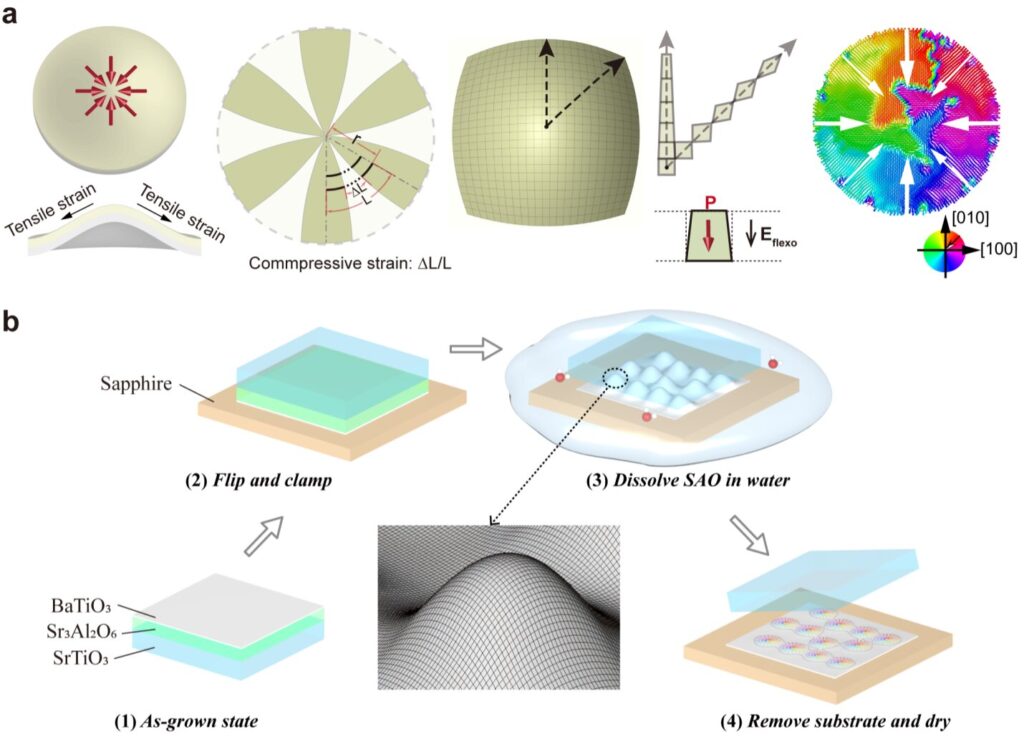Ferroelectrics are a class of materials that exhibit so-called spontaneous electric polarization, which is the separation of electric charges that can be reversed when an external electric field is applied to them. The dipole moments (i.e., pairs of equal and opposite charges) in these materials can sometimes be arranged in complex configurations known as topological textures.
The topological structures of some ferroelectric materials can interact with light in interesting and unexpected ways, which could have interesting implications for the development of optical technologies and communication systems. The size of ferroelectric polar topologies unveiled and studied to date, however, is not aligned with that of laser light modes, which limited their previous use for the development of optical technologies.
Researchers at Nanjing University recently realized a micrometer-scale center-convergent ferroelectric topology using barium titanate (BaTiO3) membranes that enables the precise spatial control of light fields.
This topology, outlined in a paper published in Nature Nanotechnology, could open new possibilities for the manipulation of light fields leveraging the topology of oxide-based ferroelectrics.
“This work began with an unexpected discovery during our team’s study of ferroelectric polarization textures in freestanding oxide membranes, like topological polar nanodomains on silicon, targeting high-density storage,” Prof. Yuefeng Nie, co-senior author of the paper, told Phys.org.
“Dr. Haoying Sun, the first author of this paper, identified micrometer-scale polar topological structures in BaTiO3 membranes. Through detailed analysis and optimized design, we achieved controlled fabrication of these micro-scale structures.”
Prof. Nie, Dr. Sun and their colleagues suspected that the micro-scale structures they identified in BaTiO3 membranes could influence light-matter interactions. To explore the potential application of these structures for light field engineering, they began collaborating with Prof. Yong Zhang, who is an expert in optical physics.
“When Prof. Nie first presented his team’s experimental data to me, I was particularly intrigued by its implications,” said Prof. Zhang, co-senior author of the paper. “Our research group has long been dedicated to exploring the generation and manipulation of vortex light fields. This spatially distributed polar topological structure provided an ideal material platform for such photonic engineering.”
As part of their study, the researchers showed that the dome-shaped configurations they unveiled can serve as a transient intermediate state while engineering the polarization of ferroelectrics. To realize the center-convergent dome-shaped topology, they first fabricated thin and planar bilayer BaTiO3 films with different strain states.

“Upon releasing from the substrate, the strain relaxation in the freestanding bilayer film drives a spontaneous 2D (planar)-to-3D (dome-shaped) structural transformation,” explained Dr. Sun, co-first author of the paper. “During this process, the radial flexoelectric field—generated via anisotropic lattice distortion—induces symmetry-breaking polarization ordering, ultimately stabilizing non-trivial 2D polar textures through geometric confinement.”
The fabrication strategy employed by Prof. Nie, Dr. Sun, Prof. Zhang and their colleagues can be used to create polarization states that are inaccessible using conventional planar epitaxy-based approaches. These states are produced leveraging the interplay between the strain and topology of oxide-based ferroelectrics.
“Our innovations manifest in two crucial aspects,” said Nie. “First, we developed a novel route for polar topological structure engineering. Unlike traditional approaches that manipulate planar thin films through epitaxial strain, thickness, or doping, we introduce an innovative technique that leverages intermediate three-dimensional deformation to construct new polarization topological structures.”
A second achievement of this recent study is that the micro-scale topological structures identified by the researchers are also designed to match the wavelength and size of lasers. In their experiments, the team successfully used center-convergent topologies to modulate the orbital angular momentum of the light field.
“The vortex light field carries orbital angular momentum, enabling high-capacity information encoding in optical storage and communication systems,” said Prof. Zhang. “The realization of vortex light field manipulation in this new material system provides new approaches for on-chip integration and photoelectric conversion.”
The recent paper by this team of researchers could soon pave the way for the discovery of other ferroelectric topologies that can be exploited for the manipulation of light, potentially opening new avenues for the advancement of optical and photonic technologies. In their next studies, Prof. Nie and his colleagues will try to enhance the modulation rate and efficiency of optical fields leveraging the same topological structures, as this could further broaden their work’s practical applications.
“In our next studies, we will also apply this innovative material preparation method to more systems to achieve a wider variety of polarization configurations and explore the manipulation of electrical, magnetic, and optical properties,” added Prof. Nie.


